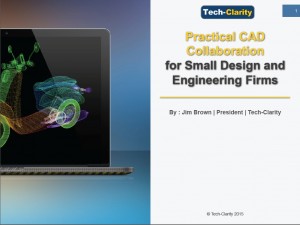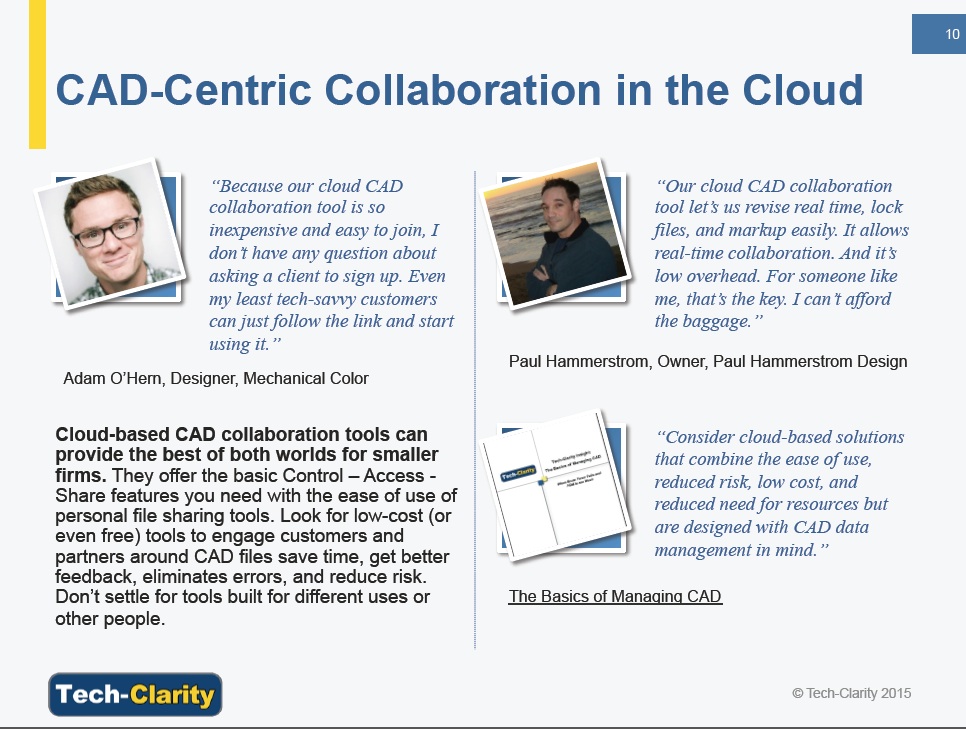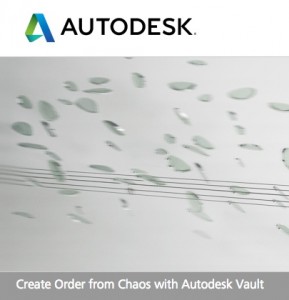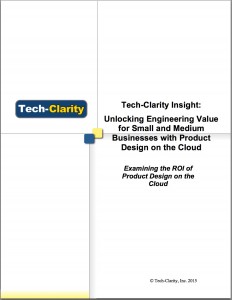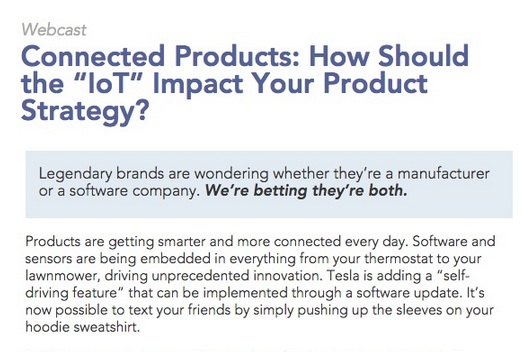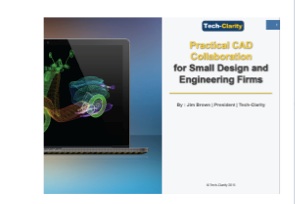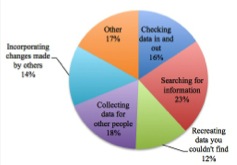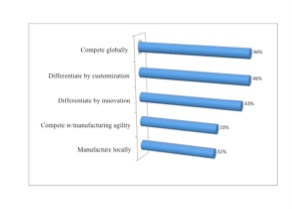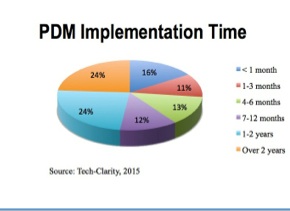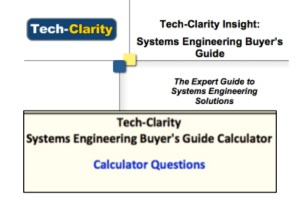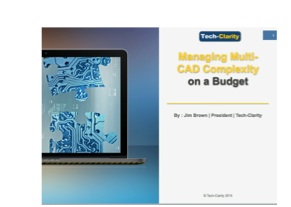Jim Brown joins Patrick Tickle of Planview to discuss the implications of the Internet of Things (IoT) on product strategy and portfolio planning. Hear how today’s manufacturing leaders wonder whether they are a manufacturer or a software company. Spoiler alert – they are becoming both. Register now for the May 13 webcast sponsored by Planview. Free…
- Executive Overview
- Lower IT Costs
- Let Innovation Drive Business Decisions
- Create Expense Flexibility
- Enable Better Collaboration
- Extend Access Beyond Engineers and Designers
- Improve Processes
- Overcome Security Concerns
- Conclusion
- Recommendations
- About the Author
Executive Overview
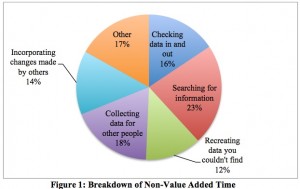 Today’s global environment is so competitive, it has become very difficult for companies to stand out from the competition. To be profitable, companies must design better products, at less cost, in less time while offering customers something unique. This can be especially challenging for small and medium size businesses (SMBs) who face many of the same challenges large companies do, but with fewer resources to address them. With this in mind, they do not have any resources to spare. Yet, research published in Tech-Clarity’s report, Reducing Non-Value Added Work in Engineering, “Engineers spend a third of their time on non-value added work. Even worse, 20% of their time is spent working with outdated information, which often leads to wasted effort and rework.” Figure 1 shows the breakdown of that non-valued added time.
Turning to a design platform on the cloud can be a way to help. The adoption of cloud technology continues to grow as applications for both personal and business applications become readily available.
As stated in Tech-Clarity’s Assessing the Cloud PLM Opportunity, “Cloud computing is generally recognized as the next generation of information technology (IT) architecture. Large and small companies alike are using cloud solutions to simplify their IT infrastructure. These companies are taking advantage of lower costs, faster time to value, and increased agility available from Internet-based applications. Many companies have already moved applications such as e-mail, customer relationship management (CRM), collaboration, and other systems into the cloud.” As an example, companies such as Salesforce.com have proven success with a cloud-based, enterprise solution, even with highly sensitive customer data. ERP is another example that is finding success on the cloud. Based on research done for Tech-Clarity’s report, Modernizing Manufacturing Systems with the Cloud, “…cloud ERP results in a better, lower risk implementation than most companies could support in-house, offering web class performance and reliability.”
Given the success of other cloud applications, it makes sense that those benefits would also extend to a design environment on the cloud. Companies such as AKKA Technologies have found just that. AKKA Technologies is a French company that provides engineering and technology consulting services for the transportation and mobility, aerospace and defense, energy, life sciences, and hi-tech industries. Philippe Obry, Chief Innovation Officer at AKKA Technologies says, “Designing products on the cloud has led to a 30-40% reduction in development time. The time savings come from combining the expertise of multiple team members on a single platform and giving them easy access to the design data.”
Such significant time savings can turn into a real competitive advantage. This report details the business value and return on investment that can be achieved when designing products on the cloud.
[post_title] => Unlocking Engineering Value for Small and Medium Businesses with Product Design on the Cloud
[post_excerpt] =>
[post_status] => publish
[comment_status] => open
[ping_status] => open
[post_password] =>
[post_name] => designroi-on-cloud
[to_ping] =>
[pinged] =>
[post_modified] => 2022-11-14 22:27:45
[post_modified_gmt] => 2022-11-15 03:27:45
[post_content_filtered] =>
[post_parent] => 0
[guid] => http://tech-clarity.com/?p=4477
[menu_order] => 0
[post_type] => post
[post_mime_type] =>
[comment_count] => 0
[filter] => raw
)
[4] => WP_Post Object
(
[ID] => 4456
[post_author] => 2572
[post_date] => 2015-03-20 13:20:51
[post_date_gmt] => 2015-03-20 17:20:51
[post_content] =>
Today’s global environment is so competitive, it has become very difficult for companies to stand out from the competition. To be profitable, companies must design better products, at less cost, in less time while offering customers something unique. This can be especially challenging for small and medium size businesses (SMBs) who face many of the same challenges large companies do, but with fewer resources to address them. With this in mind, they do not have any resources to spare. Yet, research published in Tech-Clarity’s report, Reducing Non-Value Added Work in Engineering, “Engineers spend a third of their time on non-value added work. Even worse, 20% of their time is spent working with outdated information, which often leads to wasted effort and rework.” Figure 1 shows the breakdown of that non-valued added time.
Turning to a design platform on the cloud can be a way to help. The adoption of cloud technology continues to grow as applications for both personal and business applications become readily available.
As stated in Tech-Clarity’s Assessing the Cloud PLM Opportunity, “Cloud computing is generally recognized as the next generation of information technology (IT) architecture. Large and small companies alike are using cloud solutions to simplify their IT infrastructure. These companies are taking advantage of lower costs, faster time to value, and increased agility available from Internet-based applications. Many companies have already moved applications such as e-mail, customer relationship management (CRM), collaboration, and other systems into the cloud.” As an example, companies such as Salesforce.com have proven success with a cloud-based, enterprise solution, even with highly sensitive customer data. ERP is another example that is finding success on the cloud. Based on research done for Tech-Clarity’s report, Modernizing Manufacturing Systems with the Cloud, “…cloud ERP results in a better, lower risk implementation than most companies could support in-house, offering web class performance and reliability.”
Given the success of other cloud applications, it makes sense that those benefits would also extend to a design environment on the cloud. Companies such as AKKA Technologies have found just that. AKKA Technologies is a French company that provides engineering and technology consulting services for the transportation and mobility, aerospace and defense, energy, life sciences, and hi-tech industries. Philippe Obry, Chief Innovation Officer at AKKA Technologies says, “Designing products on the cloud has led to a 30-40% reduction in development time. The time savings come from combining the expertise of multiple team members on a single platform and giving them easy access to the design data.”
Such significant time savings can turn into a real competitive advantage. This report details the business value and return on investment that can be achieved when designing products on the cloud.
[post_title] => Unlocking Engineering Value for Small and Medium Businesses with Product Design on the Cloud
[post_excerpt] =>
[post_status] => publish
[comment_status] => open
[ping_status] => open
[post_password] =>
[post_name] => designroi-on-cloud
[to_ping] =>
[pinged] =>
[post_modified] => 2022-11-14 22:27:45
[post_modified_gmt] => 2022-11-15 03:27:45
[post_content_filtered] =>
[post_parent] => 0
[guid] => http://tech-clarity.com/?p=4477
[menu_order] => 0
[post_type] => post
[post_mime_type] =>
[comment_count] => 0
[filter] => raw
)
[4] => WP_Post Object
(
[ID] => 4456
[post_author] => 2572
[post_date] => 2015-03-20 13:20:51
[post_date_gmt] => 2015-03-20 17:20:51
[post_content] =>  Join Tech-Clarity’s Michelle Boucher on this webcast for consumer goods companies. Michelle will be joined by Raymond Wodar, Director and Business Experience Consultant at Dassault Systèmes and the discussion will be moderated by Kara Romanow, Executive Editor, at CGT Consumer Goods Technology.
The webcast will be held on Wednesday, March 25 at 2:00 EDT.
You are invited to join us to learn:
Join Tech-Clarity’s Michelle Boucher on this webcast for consumer goods companies. Michelle will be joined by Raymond Wodar, Director and Business Experience Consultant at Dassault Systèmes and the discussion will be moderated by Kara Romanow, Executive Editor, at CGT Consumer Goods Technology.
The webcast will be held on Wednesday, March 25 at 2:00 EDT.
You are invited to join us to learn:
- The current state of engineering in CPG companies and how companies are managing the obstacles slowing down innovation.
- How leading companies like Barilla and MWV are leveraging technology to eliminate files and emails to cut their innovation cycle from 18 to 6 months.
- What ways companies can leverage PLM to cut innovation time in half, reduce rework and quality errors, and coordinate a complex ecosystem of functions, partners and suppliers.
 [post_title] => Accelerate Innovation with Less Non-Value Added Work Webcast
[post_excerpt] =>
[post_status] => publish
[comment_status] => open
[ping_status] => open
[post_password] =>
[post_name] => cpg_innovation
[to_ping] =>
[pinged] =>
[post_modified] => 2022-11-14 22:26:40
[post_modified_gmt] => 2022-11-15 03:26:40
[post_content_filtered] =>
[post_parent] => 0
[guid] => http://tech-clarity.com/?p=4456
[menu_order] => 0
[post_type] => post
[post_mime_type] =>
[comment_count] => 0
[filter] => raw
)
[5] => WP_Post Object
(
[ID] => 4451
[post_author] => 2572
[post_date] => 2015-03-18 10:57:07
[post_date_gmt] => 2015-03-18 14:57:07
[post_content] =>
[post_title] => Accelerate Innovation with Less Non-Value Added Work Webcast
[post_excerpt] =>
[post_status] => publish
[comment_status] => open
[ping_status] => open
[post_password] =>
[post_name] => cpg_innovation
[to_ping] =>
[pinged] =>
[post_modified] => 2022-11-14 22:26:40
[post_modified_gmt] => 2022-11-15 03:26:40
[post_content_filtered] =>
[post_parent] => 0
[guid] => http://tech-clarity.com/?p=4456
[menu_order] => 0
[post_type] => post
[post_mime_type] =>
[comment_count] => 0
[filter] => raw
)
[5] => WP_Post Object
(
[ID] => 4451
[post_author] => 2572
[post_date] => 2015-03-18 10:57:07
[post_date_gmt] => 2015-03-18 14:57:07
[post_content] =>  Tech-Clarity’s Michelle Boucher will present at DriveWorks World to share research on the business impact of a successful Engineer-to-Order process. She will highlight key best practices for both quoting and engineering that will lead to greater profitability.
The event will be held in Chicago March 16th - 20th. More information about the event can be found here and registration details are here.
[post_title] => Improving Company Profitability with ETO Success
[post_excerpt] =>
[post_status] => publish
[comment_status] => open
[ping_status] => open
[post_password] =>
[post_name] => improving-company-profitability-with-eto-success
[to_ping] =>
[pinged] =>
[post_modified] => 2022-11-14 22:26:37
[post_modified_gmt] => 2022-11-15 03:26:37
[post_content_filtered] =>
[post_parent] => 0
[guid] => http://tech-clarity.com/?p=4451
[menu_order] => 0
[post_type] => post
[post_mime_type] =>
[comment_count] => 0
[filter] => raw
)
[6] => WP_Post Object
(
[ID] => 4444
[post_author] => 2572
[post_date] => 2015-03-13 12:32:31
[post_date_gmt] => 2015-03-13 16:32:31
[post_content] =>
Tech-Clarity’s Michelle Boucher will present at DriveWorks World to share research on the business impact of a successful Engineer-to-Order process. She will highlight key best practices for both quoting and engineering that will lead to greater profitability.
The event will be held in Chicago March 16th - 20th. More information about the event can be found here and registration details are here.
[post_title] => Improving Company Profitability with ETO Success
[post_excerpt] =>
[post_status] => publish
[comment_status] => open
[ping_status] => open
[post_password] =>
[post_name] => improving-company-profitability-with-eto-success
[to_ping] =>
[pinged] =>
[post_modified] => 2022-11-14 22:26:37
[post_modified_gmt] => 2022-11-15 03:26:37
[post_content_filtered] =>
[post_parent] => 0
[guid] => http://tech-clarity.com/?p=4451
[menu_order] => 0
[post_type] => post
[post_mime_type] =>
[comment_count] => 0
[filter] => raw
)
[6] => WP_Post Object
(
[ID] => 4444
[post_author] => 2572
[post_date] => 2015-03-13 12:32:31
[post_date_gmt] => 2015-03-13 16:32:31
[post_content] => 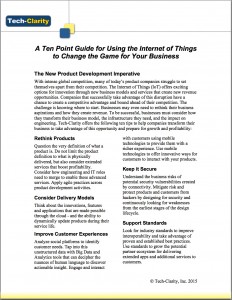 Tech-Clarity Spotlight: A Ten Point Guide for Using the Internet of Things to Change the Game for Your Business offers ten tips for companies looking to take advantage of the Internet of Things (IoT). The IoT offers great potential for companies to bring new innovations to their products, but it came be difficult to know where to start. These ten tips provide guidance to help companies get started with the IoT.
Please enjoy the summary below, or click the report title above to download the full PDF for more details (free of charge, no registration required). Special thanks to IBM for sponsoring the distribution of this research. For more information, visit IBM's continuous engineering page.
Tech-Clarity Spotlight: A Ten Point Guide for Using the Internet of Things to Change the Game for Your Business offers ten tips for companies looking to take advantage of the Internet of Things (IoT). The IoT offers great potential for companies to bring new innovations to their products, but it came be difficult to know where to start. These ten tips provide guidance to help companies get started with the IoT.
Please enjoy the summary below, or click the report title above to download the full PDF for more details (free of charge, no registration required). Special thanks to IBM for sponsoring the distribution of this research. For more information, visit IBM's continuous engineering page.
The New Product Development Imperative
With intense global competition, many of today’s product companies struggle to set themselves apart from their competition. The Internet of Things (IoT) offers exciting options for innovation through new business models and services that create new revenue opportunities. Companies that successfully take advantage of this disruption have a chance to create a competitive advantage and bound ahead of their competition. The challenge is knowing where to start. Businesses may even need to rethink their business aspirations and how they create revenue. To be successful, businesses must consider how they transform their business model, the infrastructure they need, and the impact on engineering. Tech-Clarity offers the following ten tips to help companies transform their business to take advantage of this opportunity and prepare for growth and profitability:- Rethink Products
- Consider Delivery Models
- Improve Customer Experiences
- Keep it Secure
- Support Standards
- Identify and Manage Requirements
- Derive Insight with Analytics
- Enable Reuse
- Continuously Verify and Validate
- Plan for Future Revenue
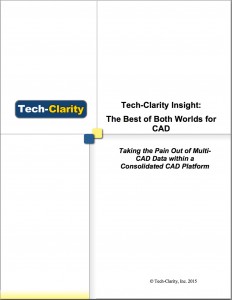 Tech-Clarity Insight: The Best of Both Worlds for CAD - Taking the Pain Out of Multi-CAD Data within a Consolidated CAD Platform explores a new technological advancement in CAD that allows direct access to multi-CAD data. The report describes how the ability to open multi-CAD data with a simple File, Open, improves efficiency and collaboration.
Please enjoy the summary below, or click the report to download a PDF overview (free of charge, no registration required).
For the full report, please visit our sponsor, PTC (free, no registration required).
Tech-Clarity Insight: The Best of Both Worlds for CAD - Taking the Pain Out of Multi-CAD Data within a Consolidated CAD Platform explores a new technological advancement in CAD that allows direct access to multi-CAD data. The report describes how the ability to open multi-CAD data with a simple File, Open, improves efficiency and collaboration.
Please enjoy the summary below, or click the report to download a PDF overview (free of charge, no registration required).
For the full report, please visit our sponsor, PTC (free, no registration required).
Table of Contents
- Executive Overview
- Realize the Value of CAD Consolidation
- Develop a Plan for Legacy Data
- Consider a Direct Approach to Support Multi-CAD Migration
- Recognize the Impact of Duplicate Objects
- Understand the Business Value of a Multi-CAD Direct Approach
- Extend to Collaboration
- Conclusion
- Recommendations
- About the Author
Executive Overview
In todays' competitive environment, companies rely on their engineers to develop the next great product that will create future revenue streams. To accomplish this and capture market share, engineers must develop innovative products with the high levels of quality and performance customers expect. This is a lot to achieve so engineers cannot afford to be distracted with non-value added work. To support the important work engineers are doing, companies should identify areas that waste time and detract from innovation. One area that can create engineering inefficiency is developing products in a multi-CAD environment. A multi-CAD environment is one where multiple types of CAD software are in use. There are numerous reasons for multi-CAD environments, including:- Suppliers may use different CAD tools
- Mergers and acquisitions of companies that use different CAD tools
- Past corporate initiatives to change CAD tools
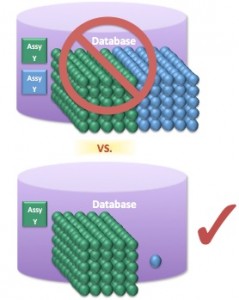 After consolidating, there is still the need to take advantage of legacy data from other CAD tools for new or revised designs - this can be a challenge. A new technological approach provides the ability to directly open multi-CAD data, without converting it. With this method, engineers can open assemblies from other CAD tools without creating ‘copies’ of the original data. Data is only converted when it needs to change as part of the overall design.
Collaborating with partners or suppliers who are using other CAD tools can also be a potential challenge. With direct access, engineers can collaborate with multi-CAD data and reference it in their assemblies, without reassembling it when it changes. This report describes some of the technical approaches within CAD tools to make working with multi-CAD data as seamless as possible, while supporting the business benefits of a consolidated CAD platform.
After consolidating, there is still the need to take advantage of legacy data from other CAD tools for new or revised designs - this can be a challenge. A new technological approach provides the ability to directly open multi-CAD data, without converting it. With this method, engineers can open assemblies from other CAD tools without creating ‘copies’ of the original data. Data is only converted when it needs to change as part of the overall design.
Collaborating with partners or suppliers who are using other CAD tools can also be a potential challenge. With direct access, engineers can collaborate with multi-CAD data and reference it in their assemblies, without reassembling it when it changes. This report describes some of the technical approaches within CAD tools to make working with multi-CAD data as seamless as possible, while supporting the business benefits of a consolidated CAD platform.
Conclusion
With the competitive pressures manufacturers face, it is important that their engineers are enabled to focus their energy on developing innovative products that will create competitive differentiation and drive profitability. To support them, companies should streamline the engineering process by identifying areas of inefficiency. Engineers commonly need to work with CAD data from multiple CAD applications. However, a multi-CAD environment can be a source of inefficiency because it is harder to share and reuse CAD data. In addition, staffing is less flexible because engineers are limited to the CAD tools they are familiar with. Consolidating on a single CAD platform, while still enabling engineers to work with multi-CAD data, can be a powerful way to address the inefficiencies. One reason for the need to work with multi-CAD data is so that legacy CAD files from other CAD applications can be reused on future designs. However, using this data typically means converting it. Requiring engineers to stop their work to convert CAD data can be very disruptive of the workflow. Converting everything at once can avoid disruption during design, but it is very expensive. Plus, typically only some legacy CAD parts will be needed in future designs. A newer approach is direct access to multi-CAD data. This enables engineers to open files from other CAD tools, directly from their CAD application with the simple menu picks, “File, Open.” With this method, multi-CAD files are opened, but not converted so duplicate objects are not created. Because of this, the engineering workflow is more streamlined, and confusion over which duplicate object is the correct file is avoided.Recommendations
Based on industry experience and research for this report, Tech-Clarity offers the following recommendations:- Understand the complete cost of operating multiple CAD systems
- Evaluate the opportunity to consolidate CAD systems to reduce cost, recognizing the multiple cost drivers go well beyond software license fees
- When consolidating, empower greater reuse by making sure there is a plan for legacy data
- Be aware of the impact converting legacy data will have on engineers and seek to minimize the impact on their workflow
- Understand the database impacts of the conversion process and seek options that will not create confusion for the rest of the enterprise
- Consider a direct approach that allows multi-CAD data to be opened using “File, Open,” without converting it or creating duplicate parts in the database
 Jim Brown will join M-Files' Greg Milliken in an informative webcast hosted by Kenneth Wong of Desktop Engineering. The webinar shares the complexity of today's engineering projects and how to combat the resulting negative business impacts. The webcast explains how companies can create an integrated view of their project-oriented information leveraging information management best practices and Enterprise Content Management (ECM) technologies.
Register Now
Jim Brown will join M-Files' Greg Milliken in an informative webcast hosted by Kenneth Wong of Desktop Engineering. The webinar shares the complexity of today's engineering projects and how to combat the resulting negative business impacts. The webcast explains how companies can create an integrated view of their project-oriented information leveraging information management best practices and Enterprise Content Management (ECM) technologies.
Register Now
 [post_title] => Webcast - Ending Project Information Chaos
[post_excerpt] =>
[post_status] => publish
[comment_status] => open
[ping_status] => open
[post_password] =>
[post_name] => webcast-de
[to_ping] =>
[pinged] =>
[post_modified] => 2022-11-14 22:26:37
[post_modified_gmt] => 2022-11-15 03:26:37
[post_content_filtered] =>
[post_parent] => 0
[guid] => http://tech-clarity.com/?p=4378
[menu_order] => 0
[post_type] => post
[post_mime_type] =>
[comment_count] => 0
[filter] => raw
)
[9] => WP_Post Object
(
[ID] => 4389
[post_author] => 2
[post_date] => 2015-03-04 13:11:54
[post_date_gmt] => 2015-03-04 18:11:54
[post_content] => Tech-Clarity's Jim Brown shares his views on how the cloud changes the PLM Return on Investment equation. The post, Cloud PLM - A Big Return with a Smaller Investment, is a guest post on the PTC Creo blog.
The post is followed by an interesting PTC video that shares information on their new product, PTC PLM Cloud.
[post_title] => Webcast - Ending Project Information Chaos
[post_excerpt] =>
[post_status] => publish
[comment_status] => open
[ping_status] => open
[post_password] =>
[post_name] => webcast-de
[to_ping] =>
[pinged] =>
[post_modified] => 2022-11-14 22:26:37
[post_modified_gmt] => 2022-11-15 03:26:37
[post_content_filtered] =>
[post_parent] => 0
[guid] => http://tech-clarity.com/?p=4378
[menu_order] => 0
[post_type] => post
[post_mime_type] =>
[comment_count] => 0
[filter] => raw
)
[9] => WP_Post Object
(
[ID] => 4389
[post_author] => 2
[post_date] => 2015-03-04 13:11:54
[post_date_gmt] => 2015-03-04 18:11:54
[post_content] => Tech-Clarity's Jim Brown shares his views on how the cloud changes the PLM Return on Investment equation. The post, Cloud PLM - A Big Return with a Smaller Investment, is a guest post on the PTC Creo blog.
The post is followed by an interesting PTC video that shares information on their new product, PTC PLM Cloud.
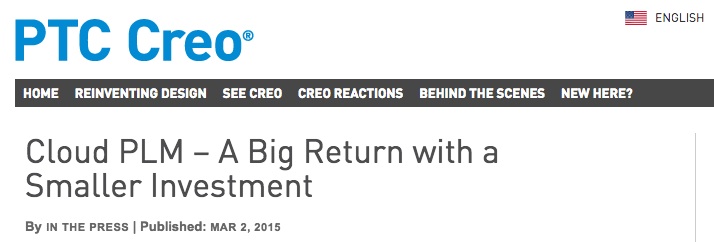 [post_title] => Cloud Changes the PLM ROI Equation - guest post
[post_excerpt] =>
[post_status] => publish
[comment_status] => open
[ping_status] => open
[post_password] =>
[post_name] => cloud-plm-roi
[to_ping] =>
[pinged] =>
[post_modified] => 2022-11-14 22:25:58
[post_modified_gmt] => 2022-11-15 03:25:58
[post_content_filtered] =>
[post_parent] => 0
[guid] => http://tech-clarity.com/?p=4389
[menu_order] => 0
[post_type] => post
[post_mime_type] =>
[comment_count] => 0
[filter] => raw
)
[10] => WP_Post Object
(
[ID] => 4158
[post_author] => 2572
[post_date] => 2015-03-03 12:14:06
[post_date_gmt] => 2015-03-03 17:14:06
[post_content] =>
[post_title] => Cloud Changes the PLM ROI Equation - guest post
[post_excerpt] =>
[post_status] => publish
[comment_status] => open
[ping_status] => open
[post_password] =>
[post_name] => cloud-plm-roi
[to_ping] =>
[pinged] =>
[post_modified] => 2022-11-14 22:25:58
[post_modified_gmt] => 2022-11-15 03:25:58
[post_content_filtered] =>
[post_parent] => 0
[guid] => http://tech-clarity.com/?p=4389
[menu_order] => 0
[post_type] => post
[post_mime_type] =>
[comment_count] => 0
[filter] => raw
)
[10] => WP_Post Object
(
[ID] => 4158
[post_author] => 2572
[post_date] => 2015-03-03 12:14:06
[post_date_gmt] => 2015-03-03 17:14:06
[post_content] => 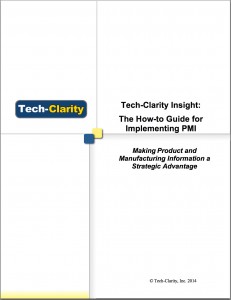 Tech-Clarity Insight: The How-to Guide for Implementing PMI – Making Product and Manufacturing Information a Strategic Advantage explores how PMI can help a company and the business value it offers. The report provides guidance to successfully implement PMI, including recommendations to support adoption.
Please enjoy the summary below, or click the report to download a PDF overview (free of charge, no registration required).
For the full report, please visit our sponsor, Siemens PLM, and their Drafting and Documentation page (free of charge, no registration required).
Tech-Clarity Insight: The How-to Guide for Implementing PMI – Making Product and Manufacturing Information a Strategic Advantage explores how PMI can help a company and the business value it offers. The report provides guidance to successfully implement PMI, including recommendations to support adoption.
Please enjoy the summary below, or click the report to download a PDF overview (free of charge, no registration required).
For the full report, please visit our sponsor, Siemens PLM, and their Drafting and Documentation page (free of charge, no registration required).
Table of Contents
- Executive Overview
- What Is PMI?
- Why Consider PMI?
- Why Should You Consider PMI Now?
- Plan for Success
- Identify Who Should be Involved
- Establish a Supportive Culture First
- Define Training Plans
- Create Demand Among Customers & Suppliers
- Start with a Pilot
- Capture Best Practices
- Conclusion
- Recommendations
- About the Author
Executive Overview
With so much global competition, companies are struggling to competitively differentiate their products any way they can. Much of this differentiation will come from engineering so it is critical for engineers to focus the majority of their energy on design work that will create that differentiation. This requires streamlining the development process so that engineers are able to focus on innovation. PMI (Product and Manufacturing Information) is a way to achieve this goal. With PMI, the need for 2D drawings is greatly reduced or eliminated altogether. Explains Jeff Erno, a Consulting Engineer for the CAD Tools and Product Definition Group at GE Power & Water, “PMI is very important to our business and supports our overall Model Based Product Definition (MBPD) initiative.” Adds Erno, “It also allows us to be more productive in producing our product definition as fewer views are needed to achieve the same goal and we can build the documentation faster than with classical drawing methods.” GE Power & Water is a provider of power generation and water technologies for utilities, independent power producers and industrial applications. PMI also enables better communication, which leads to fewer mistakes and higher quality. Andreas Pietsch, Development Body in White Manager at Daimler AG says, “It is obvious PMI saves us money by saving documentation time.” Pietsch continues, “Of course there are also less mistakes because specifications are more clear.” Enabling better communications improves relationships with suppliers. More importantly, 3D models can make it easier for customers to work with you, which is a competitive advantage. While PMI offers many advantages, adopting it does require some organizational changes, which can be difficult for any organization. However, with proper planning for PMI, the adoption process can be much easier. This report serves as a how-to guide to implement PMI and make it a success at your company. [post_title] => The How-to Guide for Implementing PMI [post_excerpt] => [post_status] => publish [comment_status] => open [ping_status] => open [post_password] => [post_name] => pmi [to_ping] => [pinged] => [post_modified] => 2022-11-14 22:27:43 [post_modified_gmt] => 2022-11-15 03:27:43 [post_content_filtered] => [post_parent] => 0 [guid] => http://tech-clarity.com/?p=4158 [menu_order] => 0 [post_type] => post [post_mime_type] => [comment_count] => 0 [filter] => raw ) [11] => WP_Post Object ( [ID] => 4363 [post_author] => 2 [post_date] => 2015-03-02 15:54:19 [post_date_gmt] => 2015-03-02 20:54:19 [post_content] =>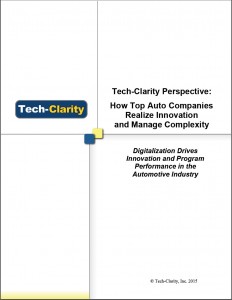 How Top Auto Companies Realize Innovation and Manage Complexity - Digitalization Drives Innovation and Program Performance in the Automotive Industry shares survey data and insights from the global automotive industry that detail the best practice processes and technologies the leaders use to drive higher profitability in the auto industry. The report shares that automotive OEMs and their supply chains are facing mounting product and product development complexity amid significant market growth. The report looks at the strategies, processes, and technologies auto companies are adopting (see graphic). Our research then analyzes the Top Performers - those reporting higher revenue and margin growth over the prior 24 months - to determine what they do differently and identifies a number of differentiating approaches detailed in the report.
Please enjoy the summary below, or click the report to download a PDF overview (free of charge, no registration required).
For the full report, please visit our sponsor, Siemens PLM, and their Automotive PLM Leadership Page (free of charge, no registration required).
How Top Auto Companies Realize Innovation and Manage Complexity - Digitalization Drives Innovation and Program Performance in the Automotive Industry shares survey data and insights from the global automotive industry that detail the best practice processes and technologies the leaders use to drive higher profitability in the auto industry. The report shares that automotive OEMs and their supply chains are facing mounting product and product development complexity amid significant market growth. The report looks at the strategies, processes, and technologies auto companies are adopting (see graphic). Our research then analyzes the Top Performers - those reporting higher revenue and margin growth over the prior 24 months - to determine what they do differently and identifies a number of differentiating approaches detailed in the report.
Please enjoy the summary below, or click the report to download a PDF overview (free of charge, no registration required).
For the full report, please visit our sponsor, Siemens PLM, and their Automotive PLM Leadership Page (free of charge, no registration required).
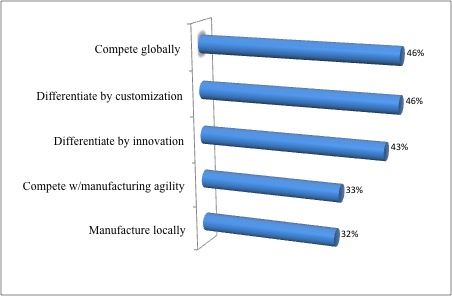 Table of Contents
Table of Contents
- Executive Overview
- Key Strategic Plans of the Auto Companies
- The Automotive Industry Faces Significant Complexity
- Identifying the Top Performers
- Collaborate / Design Concurrently between OEMs and Suppliers
- Adopt Next Level Simulation / Optimization
- Transform to Next Level Manufacturing Planning
- Enabling Technology
- Conclusion
- Recommendations
- About the Research
Executive Overview
The global automotive and transportation industry is experiencing a tremendous rejuvenation. The market is alive and sales and profits are growing. Within the last few years, automotive manufacturing has entered an age of innovation and witnessed unprecedented introduction of new models and advanced technologies to meet the challenge of doubling fuel economy and halving emissions. In parallel with the booming auto market is a growing level of product development complexity. This increased complexity results from a variety of factors ranging from advanced materials for vehicle lightweighting to the increased role of software in product innovation and product performance. Some like to say today’s cars are like computers driving around on wheels with over tens of million lines of code – but that’s a huge understatement. Today’s automobiles are an intricate orchestration of mechanical, sensors, controls, and software and are increasingly interacting with other vehicles and their surroundings. The resulting complexity is immense. How is the industry responding? Tech-Clarity analyzed survey data and reviewed automotive executive presentations to determine how automakers and suppliers address complexity and take advantage of the industry renaissance. We found that top-performing companies are going beyond today’s best practices in manufacturing and leveraging digitalization to realize innovation. These companies have transformed their vehicle development processes to take greater advantage of digital product models and simulation, leading to growth and profitability. Specifically, our research shows that Top Performers in the automotive industry are:- Continuing their lead in collaboration and concurrent design
- Expanding their use of digital product models to optimize products early in design and better validate mechanical, electrical, and software systems
- Expanding their ability to synchronize and integrate design and manufacturing
- Use more integrated, holistic PLM capabilities that allow early, model-driven systems optimization
- Integrate systems across the lifecycle to align and share design data from concept through production
 Enterprise PLM Survey
Enterprise PLM Survey
Please share your views on how manufacturers leverage Product Lifecycle Management (PLM) processes and systems.
- If you already completed the survey –> please share with a colleague or on social media using the “Share/Save” options above.
- If you haven’t taken the survey –> please:
CLICK HERE TO TAKE THE SURVEY NOW!
 In addition, 100 respondents will receive a $10 Amazon gift card. See rules and eligibility requirements below.
The survey should take no more than 10 minutes to complete. Individual responses will be kept confidential.
In addition, 100 respondents will receive a $10 Amazon gift card. See rules and eligibility requirements below.
The survey should take no more than 10 minutes to complete. Individual responses will be kept confidential.
Rules
To be eligible for this offer, you must be a professional with job responsibilities related to or supporting the development, release, or manufacture of products. Vendors and consultants who sell software, solutions, or services to support product development are not eligible. Students without professional work experience are also not eligible. A valid work email is required to receive the gift card. To verify eligibility, your work email must include the domain of your place of employment. Email addresses will be kept confidential and will not be used for any direct sales or marketing purposes. Duplicate responses will be disqualified. Winners will be notified when the survey is closed.
[post_title] => Enterprise PLM Survey [post_excerpt] => [post_status] => publish [comment_status] => open [ping_status] => open [post_password] => [post_name] => plm-survey [to_ping] => [pinged] => [post_modified] => 2022-11-14 22:28:29 [post_modified_gmt] => 2022-11-15 03:28:29 [post_content_filtered] => [post_parent] => 0 [guid] => http://tech-clarity.com/?p=4331 [menu_order] => 0 [post_type] => post [post_mime_type] => [comment_count] => 0 [filter] => raw ) [13] => WP_Post Object ( [ID] => 4276 [post_author] => 2 [post_date] => 2015-02-03 11:07:18 [post_date_gmt] => 2015-02-03 16:07:18 [post_content] =>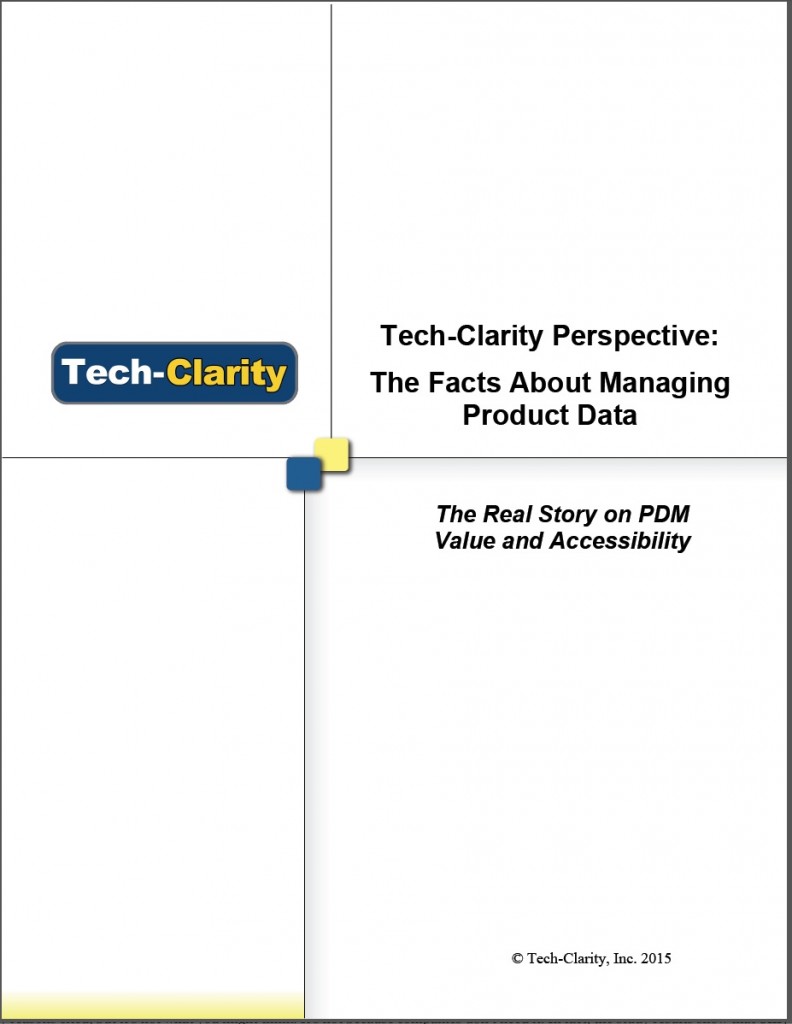 The Facts about Managing Product Data - The Real Story on PDM Value and Accessibility offers insights to help uncover the truth about managing product data. The research shares analysis of over 2,500 responses to a multi-national survey investigating the challenges, uses, and implementation experiences of companies that use CAD files. The analysis shows that Top Performers - those with better ability to develop products efficiently, design high quality products, develop products quickly, and meet design project / program cost targets - are more likely to use PDM. It also uncovers some interesting facts, for example that only 8% of manufacturers without PDM report that they don't have problems managing data.
Given that so many that could benefit from PDM haven't implemented it, the research reviews the barriers to PDM adoption. Specifically the report evaluates the belief that PDM has to take a lot of time and cost a lot of money to implement. The findings are intended to help companies make a facts-based decision on how PDM can help them improve their business by clearing up some common urban legends surrounding data management. For example, some say that companies that primarily use 2D CAD and office documents don’t benefit from PDM, which the data shows is simply not true.
Please enjoy the summary below, or click the report or title to download the full PDF (free of charge, no registration required).
For more information on managing product data please visit our sponsor, Autodesk, and their Data Management Microsite.
This paper has been translated into local languages thanks to our sponsor, Autodesk.
The Facts about Managing Product Data - The Real Story on PDM Value and Accessibility offers insights to help uncover the truth about managing product data. The research shares analysis of over 2,500 responses to a multi-national survey investigating the challenges, uses, and implementation experiences of companies that use CAD files. The analysis shows that Top Performers - those with better ability to develop products efficiently, design high quality products, develop products quickly, and meet design project / program cost targets - are more likely to use PDM. It also uncovers some interesting facts, for example that only 8% of manufacturers without PDM report that they don't have problems managing data.
Given that so many that could benefit from PDM haven't implemented it, the research reviews the barriers to PDM adoption. Specifically the report evaluates the belief that PDM has to take a lot of time and cost a lot of money to implement. The findings are intended to help companies make a facts-based decision on how PDM can help them improve their business by clearing up some common urban legends surrounding data management. For example, some say that companies that primarily use 2D CAD and office documents don’t benefit from PDM, which the data shows is simply not true.
Please enjoy the summary below, or click the report or title to download the full PDF (free of charge, no registration required).
For more information on managing product data please visit our sponsor, Autodesk, and their Data Management Microsite.
This paper has been translated into local languages thanks to our sponsor, Autodesk.
- Fakty dotyczące zarządzania danymi produktów (Polish) - (free of charge, no registration required)
- 製品データ管理に関する事実 ホワイトペーパー (Japanese) - (free of charge, no registration required)
- Wichtige Fakten zum Thema Produkt-Datenmanagement (German) - (free of charge, no registration required)
- Etude Tech-Clarity sur la Gestion des Données Produits PDM (French) - (free of charge, no registration required)
- Gestione dei dati di prodotto (Italian) - (free of charge, no registration required)
Table of Contents
- Executive Overview
- Benefits of Effective Data Management
- Design Challenges and Impacts
- Identifying the Top Performers
- Evaluating Data Management Approaches
- So Why Doesn’t Everyone Use PDM?
- The “We Don’t Use 3D” Myth
- The PDM Time and Cost Misconception
- The “We’re too Small for PDM” Myth
- Misconception that PDM is “All or Nothing”
- The Fallacy that “PDM is Only for Managing CAD Files”
- PDM is “Just an Engineering Tool”
- Conclusion
- Recommendations
- About the Author
- About the Research
Executive Overview
Product Data Management (PDM) helps companies improve the way they control, access, and share critical, product-related files and information. But perhaps more important than what PDM does, are the benefits that PDM delivers. The Tech-Clarity report The Business Value of Product Data Management explains that companies gain strategic business benefits from PDM including improved time to market, better product quality, increased innovation, improved efficiency, reduced product cost, and more. Further, our Best Practices for Managing Design Data survey concludes that operational PDM improvements “lead to better product profitability and business performance.” The value of PDM is really not disputed. But not everyone is managing data. Why? There are many reasons cited, but it’s not what you might think. It’s not because companies don’t need it. In fact, the study results show that only 8% of companies not using PDM say it’s because they don’t have any problems related to data management. So what stops people from implementing such an important tool? Too often, people don’t know the truth about PDM. For example, this research finds that about one quarter without PDM don’t understand PDM benefits (24%) and/or don’t know what PDM is (21%). There are other misconceptions as well. For example, some believe that companies that primarily use 2D CAD and office documents don’t benefit from PDM, which is simply not true. There is also a lot of misinformation about who should use PDM and how hard it is to implement. While PDM can take a lot of time and money to implement, it doesn’t have to. Others believe that only larger companies can benefit from PDM, or that it is only valuable inside of engineering. Clearly there are a lot of myths to address with facts.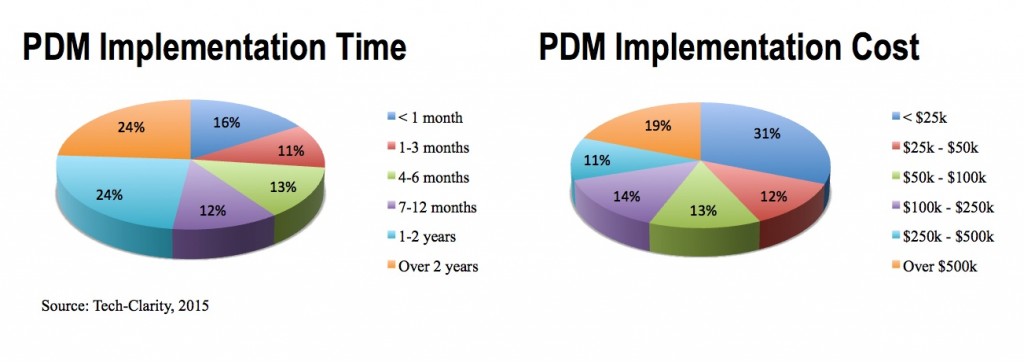 To get the real story and prompt a practical discussion, Tech-Clarity surveyed over 2,500 companies about their experiences managing data. It’s time for companies to stop believing the urban legends about PDM and get the facts so they can start improving their businesses. After all, the alternative is unmanaged (or manually managed) data, which is inefficient at best and risky at worse. As The Basics of Managing CAD explains, “Some recognize the shortcomings and risks of a manual (data) management approach, while others are one mistake away from learning the hard way.”
[post_title] => The Facts About Managing Product Data
[post_excerpt] =>
[post_status] => publish
[comment_status] => open
[ping_status] => open
[post_password] =>
[post_name] => pdm-facts
[to_ping] =>
[pinged] =>
[post_modified] => 2022-11-14 22:27:44
[post_modified_gmt] => 2022-11-15 03:27:44
[post_content_filtered] =>
[post_parent] => 0
[guid] => http://tech-clarity.com/?p=4276
[menu_order] => 0
[post_type] => post
[post_mime_type] =>
[comment_count] => 3
[filter] => raw
)
[14] => WP_Post Object
(
[ID] => 4156
[post_author] => 2572
[post_date] => 2015-01-19 08:01:05
[post_date_gmt] => 2015-01-19 13:01:05
[post_content] =>
To get the real story and prompt a practical discussion, Tech-Clarity surveyed over 2,500 companies about their experiences managing data. It’s time for companies to stop believing the urban legends about PDM and get the facts so they can start improving their businesses. After all, the alternative is unmanaged (or manually managed) data, which is inefficient at best and risky at worse. As The Basics of Managing CAD explains, “Some recognize the shortcomings and risks of a manual (data) management approach, while others are one mistake away from learning the hard way.”
[post_title] => The Facts About Managing Product Data
[post_excerpt] =>
[post_status] => publish
[comment_status] => open
[ping_status] => open
[post_password] =>
[post_name] => pdm-facts
[to_ping] =>
[pinged] =>
[post_modified] => 2022-11-14 22:27:44
[post_modified_gmt] => 2022-11-15 03:27:44
[post_content_filtered] =>
[post_parent] => 0
[guid] => http://tech-clarity.com/?p=4276
[menu_order] => 0
[post_type] => post
[post_mime_type] =>
[comment_count] => 3
[filter] => raw
)
[14] => WP_Post Object
(
[ID] => 4156
[post_author] => 2572
[post_date] => 2015-01-19 08:01:05
[post_date_gmt] => 2015-01-19 13:01:05
[post_content] => 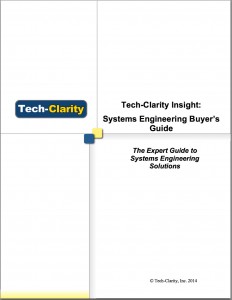 Tech-Clarity's Systems Engineering Buyer’s Guide helps manufacturers develop criteria to evaluate software solutions to support Systems Engineering on a set of high level criteria. Tech-Clarity’s Buyer’s Guides go beyond software functionality to provide a framework of requirements that impact implementation success and long-term ROI, including:
Tech-Clarity's Systems Engineering Buyer’s Guide helps manufacturers develop criteria to evaluate software solutions to support Systems Engineering on a set of high level criteria. Tech-Clarity’s Buyer’s Guides go beyond software functionality to provide a framework of requirements that impact implementation success and long-term ROI, including:
- Software capabilities
- Implementation
- User adoption
- Support
- Vendor characteristics / attributes
- Industry or unique business needs
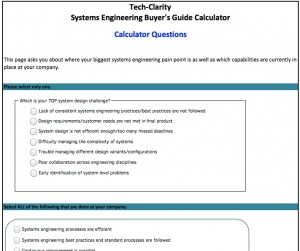 an interactive assessment based on our Systems Engineering Buyer’s Guide. The assessment asks where you have the most trouble as well as your company's current capabilities. It then uses your responses to recommend the top three areas of systems engineering you should look at first.
To download this interactive assessment please visit our sponsor, PTC, here (free of charge, registration required) and receive personalized recommendations to help you prioritize buying criteria based on your company's needs.
an interactive assessment based on our Systems Engineering Buyer’s Guide. The assessment asks where you have the most trouble as well as your company's current capabilities. It then uses your responses to recommend the top three areas of systems engineering you should look at first.
To download this interactive assessment please visit our sponsor, PTC, here (free of charge, registration required) and receive personalized recommendations to help you prioritize buying criteria based on your company's needs.
Table of Contents
- Executive Overview
- The Business Value of Systems Engineering
- Start with Process Definition
- Manage Requirements
- Design the System
- Design the System to Be Modular
- Support Product Line Variants
- Enable Detailed Design
- Verify and Validate the System
- Assess Service Requirements
- Consider Vendor Attributes
- Identify Specific Needs for your Company
- Conclusion
- Recommendations
- About the Author
Executive Overview
In today’s world, fierce global competition is driving companies to seek new ways to competitively differentiate their products. Many companies are incorporating embedded software into their products to set their products apart from the competition. Embedded software offers opportunities to incorporate intelligence into a product as well as offer customers a more personalized experience. The Internet of Things (IoT) takes this even further by creating exciting possibilities for new and differentiated services for products with smart, connected devices. However, taking advantage of this requires expert systems engineering practices. While bringing together mechanical components, electronics, and software presents exciting opportunities for innovation, it also brings unique challenges and adds new levels of complexity to today’s products and product development processes. Consequently, expert systems engineering practices are critical to the success of today’s products. A key part of implementing expert systems engineering practices is having the technology to support them. This buyer’s guide will help manufacturers select the right software to support systems engineering. This guide is composed of four major sections covering, systems engineering software tool functionality, service requirements, vendor attributes, and special company considerations (Figure 1). Each section includes a checklist with key requirements to investigate when selecting software tools to support systems engineering.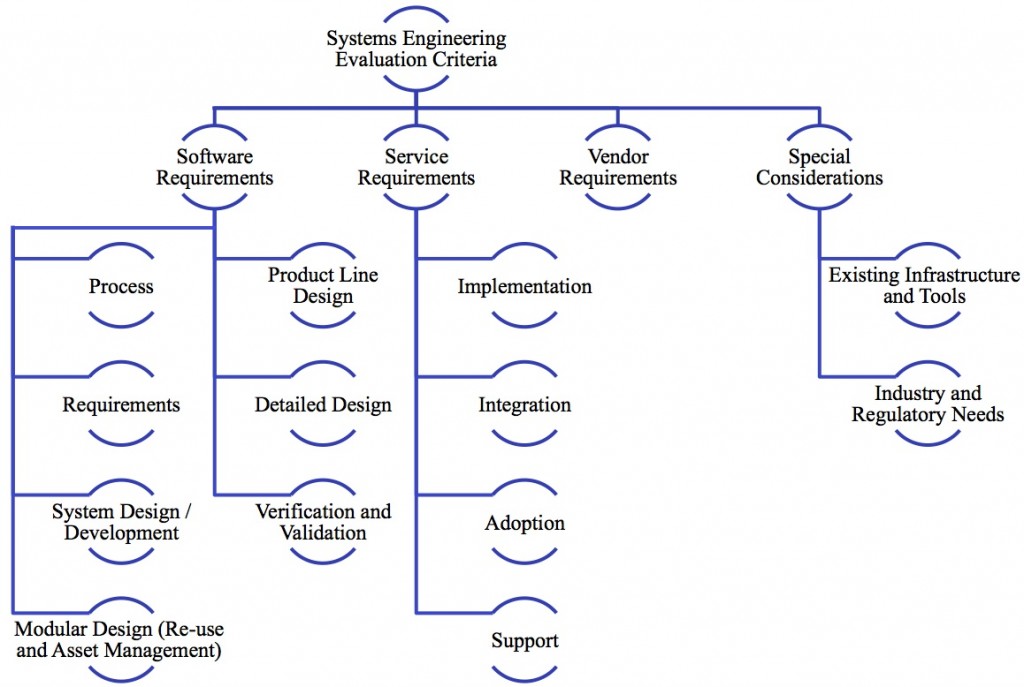 To set the foundation for expert systems engineering practices, companies should focus on the entire systems engineering process, ensuring there are solutions for all aspects of systems engineering. This will enable companies to be even more competitive in ways that will lead to higher growth and greater profitability.
This guide is not an all-encompassing requirements list. It provides a high level overview for systems engineering. In addition to the systems engineering capabilities discussed in this buyer’s guide, companies should also consider needs for the tools of individual engineers for each engineering discipline.
[post_title] => Systems Engineering Buyer’s Guide
[post_excerpt] =>
[post_status] => publish
[comment_status] => open
[ping_status] => open
[post_password] =>
[post_name] => se-guide
[to_ping] =>
[pinged] =>
[post_modified] => 2022-11-14 22:27:42
[post_modified_gmt] => 2022-11-15 03:27:42
[post_content_filtered] =>
[post_parent] => 0
[guid] => http://tech-clarity.com/?p=4156
[menu_order] => 0
[post_type] => post
[post_mime_type] =>
[comment_count] => 0
[filter] => raw
)
[15] => WP_Post Object
(
[ID] => 4221
[post_author] => 2
[post_date] => 2015-01-14 14:25:20
[post_date_gmt] => 2015-01-14 19:25:20
[post_content] => Join Tech-Clarity's Jim Brown on this webcast as he presents his views on PLM and how cloud offerings help to drop the barriers to entry. In addition, hear from Mike Gurican of Autodesk give an overview of PLM and PLM360 and discuss common issues that PLM improves, including BOM and Change Management.
To set the foundation for expert systems engineering practices, companies should focus on the entire systems engineering process, ensuring there are solutions for all aspects of systems engineering. This will enable companies to be even more competitive in ways that will lead to higher growth and greater profitability.
This guide is not an all-encompassing requirements list. It provides a high level overview for systems engineering. In addition to the systems engineering capabilities discussed in this buyer’s guide, companies should also consider needs for the tools of individual engineers for each engineering discipline.
[post_title] => Systems Engineering Buyer’s Guide
[post_excerpt] =>
[post_status] => publish
[comment_status] => open
[ping_status] => open
[post_password] =>
[post_name] => se-guide
[to_ping] =>
[pinged] =>
[post_modified] => 2022-11-14 22:27:42
[post_modified_gmt] => 2022-11-15 03:27:42
[post_content_filtered] =>
[post_parent] => 0
[guid] => http://tech-clarity.com/?p=4156
[menu_order] => 0
[post_type] => post
[post_mime_type] =>
[comment_count] => 0
[filter] => raw
)
[15] => WP_Post Object
(
[ID] => 4221
[post_author] => 2
[post_date] => 2015-01-14 14:25:20
[post_date_gmt] => 2015-01-14 19:25:20
[post_content] => Join Tech-Clarity's Jim Brown on this webcast as he presents his views on PLM and how cloud offerings help to drop the barriers to entry. In addition, hear from Mike Gurican of Autodesk give an overview of PLM and PLM360 and discuss common issues that PLM improves, including BOM and Change Management.
 The webcast is sponsored by MasterGraphics and will air on Wednesday, January 28th at 11:30 AM (Eastern Time).
The recorded webcast is now available (free, registration required) thanks to the sponsor, MasterGraphics.
The webcast is sponsored by MasterGraphics and will air on Wednesday, January 28th at 11:30 AM (Eastern Time).
The recorded webcast is now available (free, registration required) thanks to the sponsor, MasterGraphics.
 [post_title] => Cloud PLM Webcast
[post_excerpt] =>
[post_status] => publish
[comment_status] => open
[ping_status] => open
[post_password] =>
[post_name] => plm-webcast
[to_ping] =>
[pinged] =>
[post_modified] => 2022-11-14 22:26:40
[post_modified_gmt] => 2022-11-15 03:26:40
[post_content_filtered] =>
[post_parent] => 0
[guid] => http://tech-clarity.com/?p=4221
[menu_order] => 0
[post_type] => post
[post_mime_type] =>
[comment_count] => 4
[filter] => raw
)
[16] => WP_Post Object
(
[ID] => 4205
[post_author] => 2
[post_date] => 2015-01-12 16:53:13
[post_date_gmt] => 2015-01-12 21:53:13
[post_content] =>
[post_title] => Cloud PLM Webcast
[post_excerpt] =>
[post_status] => publish
[comment_status] => open
[ping_status] => open
[post_password] =>
[post_name] => plm-webcast
[to_ping] =>
[pinged] =>
[post_modified] => 2022-11-14 22:26:40
[post_modified_gmt] => 2022-11-15 03:26:40
[post_content_filtered] =>
[post_parent] => 0
[guid] => http://tech-clarity.com/?p=4221
[menu_order] => 0
[post_type] => post
[post_mime_type] =>
[comment_count] => 4
[filter] => raw
)
[16] => WP_Post Object
(
[ID] => 4205
[post_author] => 2
[post_date] => 2015-01-12 16:53:13
[post_date_gmt] => 2015-01-12 21:53:13
[post_content] => 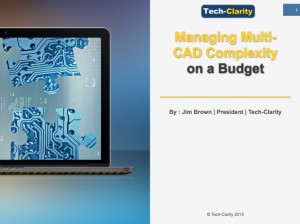 The Managing Multi-CAD Complexity on a Budget eBook discusses the challenges of managing multi-CAD data and continues the conversation started in Tech-Clarity Insight The Basics of Managing CAD about whether a simpler, lower overhead, cloud-based data management solution is enough to manage CAD files. The eBook shares the experiences of engineers from Synaptics, Interactive CAD Solutions, and Moss Designs in dealing with the reality of multi-CAD. The eBook concludes that a lower overhead, cloud-based solution is a valid option to manage multi-CAD data management complexity.
Please enjoy the summary below, or click the report to download a PDF overview (free of charge, no registration required).
For the full multi-CAD ebook, please visit our sponsor GrabCAD (free, registration required).
The Managing Multi-CAD Complexity on a Budget eBook discusses the challenges of managing multi-CAD data and continues the conversation started in Tech-Clarity Insight The Basics of Managing CAD about whether a simpler, lower overhead, cloud-based data management solution is enough to manage CAD files. The eBook shares the experiences of engineers from Synaptics, Interactive CAD Solutions, and Moss Designs in dealing with the reality of multi-CAD. The eBook concludes that a lower overhead, cloud-based solution is a valid option to manage multi-CAD data management complexity.
Please enjoy the summary below, or click the report to download a PDF overview (free of charge, no registration required).
For the full multi-CAD ebook, please visit our sponsor GrabCAD (free, registration required).
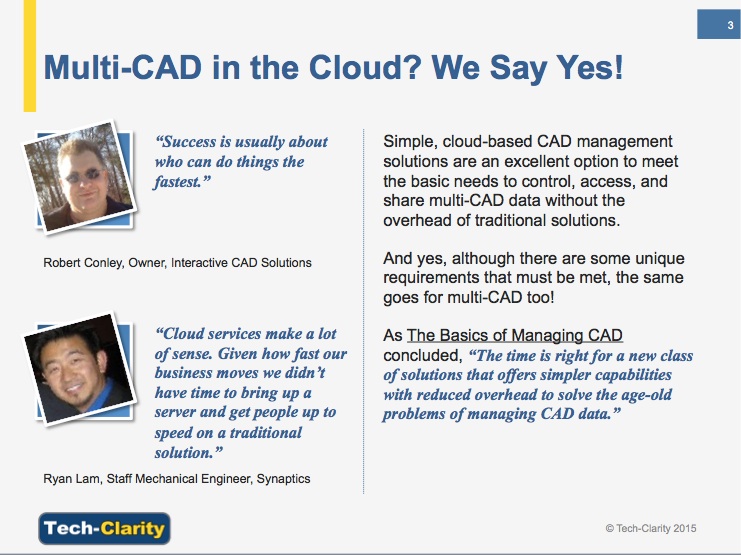 [post_title] => Managing Multi-CAD on a Budget
[post_excerpt] =>
[post_status] => publish
[comment_status] => open
[ping_status] => open
[post_password] =>
[post_name] => multicad-pdm
[to_ping] =>
[pinged] =>
[post_modified] => 2022-11-14 22:28:07
[post_modified_gmt] => 2022-11-15 03:28:07
[post_content_filtered] =>
[post_parent] => 0
[guid] => http://tech-clarity.com/?p=4205
[menu_order] => 0
[post_type] => post
[post_mime_type] =>
[comment_count] => 0
[filter] => raw
)
[17] => WP_Post Object
(
[ID] => 4199
[post_author] => 2572
[post_date] => 2014-12-17 15:19:46
[post_date_gmt] => 2014-12-17 20:19:46
[post_content] =>
[post_title] => Managing Multi-CAD on a Budget
[post_excerpt] =>
[post_status] => publish
[comment_status] => open
[ping_status] => open
[post_password] =>
[post_name] => multicad-pdm
[to_ping] =>
[pinged] =>
[post_modified] => 2022-11-14 22:28:07
[post_modified_gmt] => 2022-11-15 03:28:07
[post_content_filtered] =>
[post_parent] => 0
[guid] => http://tech-clarity.com/?p=4205
[menu_order] => 0
[post_type] => post
[post_mime_type] =>
[comment_count] => 0
[filter] => raw
)
[17] => WP_Post Object
(
[ID] => 4199
[post_author] => 2572
[post_date] => 2014-12-17 15:19:46
[post_date_gmt] => 2014-12-17 20:19:46
[post_content] =>  Tech-Clarity is conducting a research study on how top performing consumer goods companies manage their product design process. Past research from Tech-Clarity found that top performers spend 25% less time on nonproductive data management tasks. That gives engineers more time to innovate or allows managers to significantly reduce design cycle times. We are conducting a research study to explore this further to examine the challenges that impact engineering and design efficiency of consumer goods companies. Thank you for your interest and your participation in our survey!
Those who respond by Friday January 23, 2015 will be entered into a drawing to receive one of 20 $25 Amazon gift cards.*
The survey should take no more than 10-15 minutes to complete.
Tech-Clarity is conducting a research study on how top performing consumer goods companies manage their product design process. Past research from Tech-Clarity found that top performers spend 25% less time on nonproductive data management tasks. That gives engineers more time to innovate or allows managers to significantly reduce design cycle times. We are conducting a research study to explore this further to examine the challenges that impact engineering and design efficiency of consumer goods companies. Thank you for your interest and your participation in our survey!
Those who respond by Friday January 23, 2015 will be entered into a drawing to receive one of 20 $25 Amazon gift cards.*
The survey should take no more than 10-15 minutes to complete.
- If you already completed the survey --> please share with a colleague using the "Share/Save" options above.
- If you haven't taken the survey --> please:
click here to take the survey now!
 Tell us how satisfied you are with your PDM / PLM system!
Tell us how satisfied you are with your PDM / PLM system!
- This survey is now closed. We are in the process of determining the winners of the incentives.
 In addition, 200 respondents will receive a $10 Amazon gift card. See rules and eligibility requirements below.
The survey should take no more than 10 minutes to complete.
In addition, 200 respondents will receive a $10 Amazon gift card. See rules and eligibility requirements below.
The survey should take no more than 10 minutes to complete.
More Information
Tech-Clarity is conducting a research study to determine the level of satisfaction users have with their PLM/PDM systems. Individual responses will be used in aggregate form only. We may publish comments and share information from those that explicitly agree that we may do so.Rules
To be eligible for this offer, you must be a professional with job responsibilities related to or supporting the development, release, or manufacture of products. Vendors and consultants who sell software, solutions, or services to support product development are not eligible. Students without professional work experience are also not eligible. A valid work email is required to receive the gift card. To verify eligibility, your work email must include the domain of your place of employment. Email addresses will be kept confidential and will not be used for any direct sales or marketing purposes unless you specifically opt in. Duplicate responses will be disqualified. Winners will be notified when the survey is closed.
[post_title] => PLM User Satisfaction Survey [post_excerpt] => [post_status] => publish [comment_status] => open [ping_status] => open [post_password] => [post_name] => plm-sat-survey [to_ping] => [pinged] => [post_modified] => 2022-11-14 22:27:43 [post_modified_gmt] => 2022-11-15 03:27:43 [post_content_filtered] => [post_parent] => 0 [guid] => http://tech-clarity.com/?p=4179 [menu_order] => 0 [post_type] => post [post_mime_type] => [comment_count] => 2 [filter] => raw ) [19] => WP_Post Object ( [ID] => 4147 [post_author] => 2572 [post_date] => 2014-12-03 13:14:02 [post_date_gmt] => 2014-12-03 18:14:02 [post_content] =>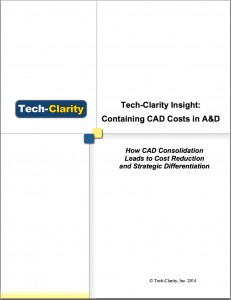 Tech-Clarity Insight: Containing CAD Costs in A&D - How CAD Consolidation Leads to Cost Reduction and Strategic Differentiation explores how aerospace and defense companies can save money by consolidating CAD solutions. The report examines key criteria in a CAD solution that are needed to support design best practices for A&D companies.
Please enjoy the summary below, or click the report to download a PDF overview (free of charge, no registration required).
For the full report, please visit our sponsor Siemens at their Aerospace & Defense page.
Watch the related episode of Tech-Clarity TV, Consolidating CAD for A&D.
Tech-Clarity Insight: Containing CAD Costs in A&D - How CAD Consolidation Leads to Cost Reduction and Strategic Differentiation explores how aerospace and defense companies can save money by consolidating CAD solutions. The report examines key criteria in a CAD solution that are needed to support design best practices for A&D companies.
Please enjoy the summary below, or click the report to download a PDF overview (free of charge, no registration required).
For the full report, please visit our sponsor Siemens at their Aerospace & Defense page.
Watch the related episode of Tech-Clarity TV, Consolidating CAD for A&D.
Table of Contents
- Executive Overview
- Considerations for A&D
- Consider CAD Consolidation to Reduce Cost
- Low Cost of Solution Ownership
- Improve Collaboration with Suppliers/Customers
- Increase Reuse
- Support Lightweight Aircraft Design
- Capture a System Level View
- Identify Problems Early
- Extend Access to Engineering Information Beyond Engineering
- Conclusion
- Recommendations
- About the Author
Executive Overview
The Aerospace and Defense (A&D) industry faces significant pressure to manage costs. In an industry fraught with cost overruns and missed deadlines, those who are most successful removing cost enjoy competitive differentiation and greater profitability. One strategy to remove cost from the development process is to consolidate Computer Aided Design (CAD) applications. Past research from Tech-Clarity shows there are significant cost savings from CAD consolidation. This report builds upon that research with a focus on A&D. While cost may be the initial reason for considering CAD consolidation, the benefits go far beyond cost. As Tech-Clarity’s Consolidating CAD – The Benefits of a Unified CAD Strategy points out, “Cost savings are attractive and are certainly attainable through consolidation. Beyond cost savings, though, are even greater strategic benefits.” With this in mind, it is important to ensure the unified CAD solution supports best practices in A&D design. This will have the twofold impact of driving innovation as well as saving costs. Part of these savings comes from the ability to take advantage of proven, repeatable processes. It’s easier for the entire team to be following the same repeatable process when using consistent tools. Repeatable processes mean greater efficiency plus less risk that will drive up costs. Selecting the right tool is an important part of making sure those processes and best practices are supported. The right tool is one that has the breadth of solution to support those design practices to not only support today’s needs, but also the ability to carry A&D companies decades into the future. [post_title] => Containing CAD Costs in A&D [post_excerpt] => [post_status] => publish [comment_status] => open [ping_status] => open [post_password] => [post_name] => cad-costs-ad [to_ping] => [pinged] => [post_modified] => 2022-11-14 22:27:41 [post_modified_gmt] => 2022-11-15 03:27:41 [post_content_filtered] => [post_parent] => 0 [guid] => http://tech-clarity.com/?p=4147 [menu_order] => 0 [post_type] => post [post_mime_type] => [comment_count] => 0 [filter] => raw ) ) [post_count] => 20 [current_post] => -1 [before_loop] => 1 [in_the_loop] => [post] => WP_Post Object ( [ID] => 4516 [post_author] => 2 [post_date] => 2015-05-05 15:08:10 [post_date_gmt] => 2015-05-05 19:08:10 [post_content] => Jim Brown joins Patrick Tickle of Planview to discuss the implications of the Internet of Things (IoT) on product strategy and portfolio planning. Hear how today's manufacturing leaders wonder whether they are a manufacturer or a software company. Spoiler alert - they are becoming both. Register now for the May 13 webcast sponsored by Planview. Free of charge, registration required.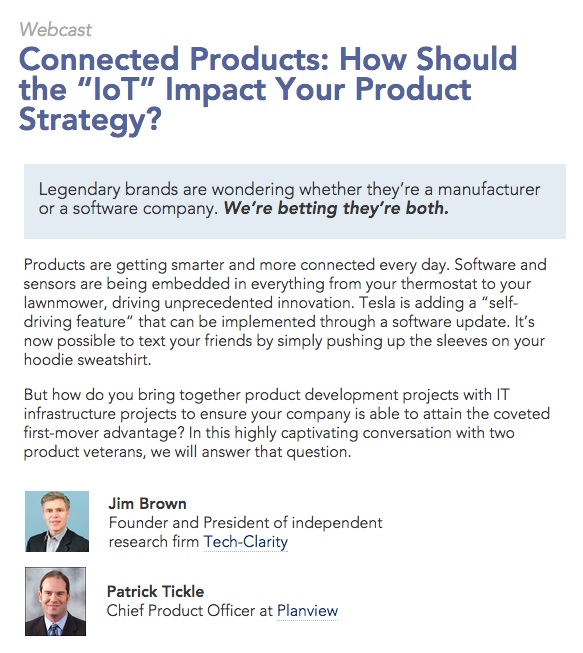 [post_title] => Webcast - IoT Impact on Product Strategy / Portfolio Management
[post_excerpt] =>
[post_status] => publish
[comment_status] => open
[ping_status] => open
[post_password] =>
[post_name] => iot-ppm
[to_ping] =>
[pinged] =>
[post_modified] => 2022-11-14 22:26:42
[post_modified_gmt] => 2022-11-15 03:26:42
[post_content_filtered] =>
[post_parent] => 0
[guid] => http://tech-clarity.com/?p=4516
[menu_order] => 0
[post_type] => post
[post_mime_type] =>
[comment_count] => 0
[filter] => raw
)
[comment_count] => 0
[current_comment] => -1
[found_posts] => 802
[max_num_pages] => 41
[max_num_comment_pages] => 0
[is_single] =>
[is_preview] =>
[is_page] =>
[is_archive] =>
[is_date] =>
[is_year] =>
[is_month] =>
[is_day] =>
[is_time] =>
[is_author] =>
[is_category] =>
[is_tag] =>
[is_tax] =>
[is_search] =>
[is_feed] =>
[is_comment_feed] =>
[is_trackback] =>
[is_home] => 1
[is_privacy_policy] =>
[is_404] =>
[is_embed] =>
[is_paged] =>
[is_admin] =>
[is_attachment] =>
[is_singular] =>
[is_robots] =>
[is_favicon] =>
[is_posts_page] =>
[is_post_type_archive] =>
[query_vars_hash:WP_Query:private] => 89c2e1fbb9fbcd38f0b5fb0f703c6b39
[query_vars_changed:WP_Query:private] => 1
[thumbnails_cached] =>
[allow_query_attachment_by_filename:protected] =>
[stopwords:WP_Query:private] =>
[compat_fields:WP_Query:private] => Array
(
[0] => query_vars_hash
[1] => query_vars_changed
)
[compat_methods:WP_Query:private] => Array
(
[0] => init_query_flags
[1] => parse_tax_query
)
[query_cache_key:WP_Query:private] => wp_query:c21e23ac15f1d71cb0441b89ee247fe6:0.15052200 17646598120.16205200 1764659812
)
[post_title] => Webcast - IoT Impact on Product Strategy / Portfolio Management
[post_excerpt] =>
[post_status] => publish
[comment_status] => open
[ping_status] => open
[post_password] =>
[post_name] => iot-ppm
[to_ping] =>
[pinged] =>
[post_modified] => 2022-11-14 22:26:42
[post_modified_gmt] => 2022-11-15 03:26:42
[post_content_filtered] =>
[post_parent] => 0
[guid] => http://tech-clarity.com/?p=4516
[menu_order] => 0
[post_type] => post
[post_mime_type] =>
[comment_count] => 0
[filter] => raw
)
[comment_count] => 0
[current_comment] => -1
[found_posts] => 802
[max_num_pages] => 41
[max_num_comment_pages] => 0
[is_single] =>
[is_preview] =>
[is_page] =>
[is_archive] =>
[is_date] =>
[is_year] =>
[is_month] =>
[is_day] =>
[is_time] =>
[is_author] =>
[is_category] =>
[is_tag] =>
[is_tax] =>
[is_search] =>
[is_feed] =>
[is_comment_feed] =>
[is_trackback] =>
[is_home] => 1
[is_privacy_policy] =>
[is_404] =>
[is_embed] =>
[is_paged] =>
[is_admin] =>
[is_attachment] =>
[is_singular] =>
[is_robots] =>
[is_favicon] =>
[is_posts_page] =>
[is_post_type_archive] =>
[query_vars_hash:WP_Query:private] => 89c2e1fbb9fbcd38f0b5fb0f703c6b39
[query_vars_changed:WP_Query:private] => 1
[thumbnails_cached] =>
[allow_query_attachment_by_filename:protected] =>
[stopwords:WP_Query:private] =>
[compat_fields:WP_Query:private] => Array
(
[0] => query_vars_hash
[1] => query_vars_changed
)
[compat_methods:WP_Query:private] => Array
(
[0] => init_query_flags
[1] => parse_tax_query
)
[query_cache_key:WP_Query:private] => wp_query:c21e23ac15f1d71cb0441b89ee247fe6:0.15052200 17646598120.16205200 1764659812
)
All Results for "All"
CAD Collaboration for Small Design and Engineering Firms
The CAD Collaboration for Small Design and Engineering Firms eBook explores the challenges of sharing CAD and related design data with customers and 3rd parties and how cloud-based CAD management solutions can help. The report furthers the discussion started in Tech-Clarity Insight – The Basics of Managing CAD about whether a simpler, lower overhead, cloud-based data management solution can…
Jim Brown Shares Data Management Research on “Create Order from Chaos with Autodesk Vault” Webcast
Jim Brown will join Jeff Makarewicz of Giffin, Inc. and Autodesk’s Kevin Robinson to share insights about product data management (PDM) on this exciting webcast on Tuesday, April 21. The presenters will discuss the findings from the report and how they impact manufacturers including Giffin. Register now!
Unlocking Engineering Value for Small and Medium Businesses with Product Design on the Cloud
Tech-Clarity Insight: Unlocking Engineering Value for Small and Medium Businesses with Product Design on the Cloud explores the business benefits of a design environment on the cloud. The report examines the savings from an IT perspective as well as the strategic value and competitive advantage it can provide product development. Please enjoy the summary below, or for the…
Accelerate Innovation with Less Non-Value Added Work Webcast
Join Tech-Clarity’s Michelle Boucher on this webcast for consumer goods companies. Michelle will be joined by Raymond Wodar, Director and Business Experience Consultant at Dassault Systèmes and the discussion will be moderated by Kara Romanow, Executive Editor, at CGT Consumer Goods Technology. The webcast will be held on Wednesday, March 25 at 2:00 EDT. You are invited to join us to learn:…
Improving Company Profitability with ETO Success
Tech-Clarity’s Michelle Boucher will present at DriveWorks World to share research on the business impact of a successful Engineer-to-Order process. She will highlight key best practices for both quoting and engineering that will lead to greater profitability. The event will be held in Chicago March 16th – 20th. More information about the event can be found…
A Ten Point Guide for Using the Internet of Things to Change the Game for Your Business
Tech-Clarity Spotlight: A Ten Point Guide for Using the Internet of Things to Change the Game for Your Business offers ten tips for companies looking to take advantage of the Internet of Things (IoT). The IoT offers great potential for companies to bring new innovations to their products, but it came be difficult to know where to start….
The Best of Both Worlds for CAD – Taking the Pain out of Multi-CAD Data within a Consolidated CAD Platform
Tech-Clarity Insight: The Best of Both Worlds for CAD – Taking the Pain Out of Multi-CAD Data within a Consolidated CAD Platform explores a new technological advancement in CAD that allows direct access to multi-CAD data. The report describes how the ability to open multi-CAD data with a simple File, Open, improves efficiency and collaboration. Please enjoy the…
Webcast – Ending Project Information Chaos
Jim Brown will join M-Files‘ Greg Milliken in an informative webcast hosted by Kenneth Wong of Desktop Engineering. The webinar shares the complexity of today’s engineering projects and how to combat the resulting negative business impacts. The webcast explains how companies can create an integrated view of their project-oriented information leveraging information management best practices and Enterprise Content Management…
Cloud Changes the PLM ROI Equation – guest post
Tech-Clarity’s Jim Brown shares his views on how the cloud changes the PLM Return on Investment equation. The post, Cloud PLM – A Big Return with a Smaller Investment, is a guest post on the PTC Creo blog. The post is followed by an interesting PTC video that shares information on their new product, PTC PLM Cloud.
The How-to Guide for Implementing PMI
Tech-Clarity Insight: The How-to Guide for Implementing PMI – Making Product and Manufacturing Information a Strategic Advantage explores how PMI can help a company and the business value it offers. The report provides guidance to successfully implement PMI, including recommendations to support adoption. Please enjoy the summary below, or click the report to download a PDF overview (free…
How Top Auto Companies Realize Innovation and Manage Complexity
How Top Auto Companies Realize Innovation and Manage Complexity – Digitalization Drives Innovation and Program Performance in the Automotive Industry shares survey data and insights from the global automotive industry that detail the best practice processes and technologies the leaders use to drive higher profitability in the auto industry. The report shares that automotive OEMs and their…
Enterprise PLM Survey
Enterprise PLM Survey Please share your views on how manufacturers leverage Product Lifecycle Management (PLM) processes and systems. If you already completed the survey –> please share with a colleague or on social media using the “Share/Save” options above. If you haven’t taken the survey –> please: CLICK HERE TO TAKE THE SURVEY NOW! Please fill out this questionnaire to receive…
The Facts About Managing Product Data
The Facts about Managing Product Data – The Real Story on PDM Value and Accessibility offers insights to help uncover the truth about managing product data. The research shares analysis of over 2,500 responses to a multi-national survey investigating the challenges, uses, and implementation experiences of companies that use CAD files. The analysis shows that Top Performers – those with better…
Systems Engineering Buyer’s Guide
Tech-Clarity’s Systems Engineering Buyer’s Guide helps manufacturers develop criteria to evaluate software solutions to support Systems Engineering on a set of high level criteria. Tech-Clarity’s Buyer’s Guides go beyond software functionality to provide a framework of requirements that impact implementation success and long-term ROI, including: Software capabilities Implementation User adoption Support Vendor characteristics / attributes Industry or…
Cloud PLM Webcast
Join Tech-Clarity’s Jim Brown on this webcast as he presents his views on PLM and how cloud offerings help to drop the barriers to entry. In addition, hear from Mike Gurican of Autodesk give an overview of PLM and PLM360 and discuss common issues that PLM improves, including BOM and Change Management. The webcast is sponsored by MasterGraphics and will air…
Managing Multi-CAD on a Budget
The Managing Multi-CAD Complexity on a Budget eBook discusses the challenges of managing multi-CAD data and continues the conversation started in Tech-Clarity Insight The Basics of Managing CAD about whether a simpler, lower overhead, cloud-based data management solution is enough to manage CAD files. The eBook shares the experiences of engineers from Synaptics, Interactive CAD Solutions,…
CPG Survey: Product Design Efficiency
Tech-Clarity is conducting a research study on how top performing consumer goods companies manage their product design process. Past research from Tech-Clarity found that top performers spend 25% less time on nonproductive data management tasks. That gives engineers more time to innovate or allows managers to significantly reduce design cycle times. We are conducting a research study…
PLM User Satisfaction Survey
Tell us how satisfied you are with your PDM / PLM system! This survey is now closed. We are in the process of determining the winners of the incentives. Please fill out this questionnaire to receive a free copy of the final report. In addition, 200 respondents will receive a $10 Amazon gift card. See…
Containing CAD Costs in A&D
Tech-Clarity Insight: Containing CAD Costs in A&D – How CAD Consolidation Leads to Cost Reduction and Strategic Differentiation explores how aerospace and defense companies can save money by consolidating CAD solutions. The report examines key criteria in a CAD solution that are needed to support design best practices for A&D companies. Please enjoy the summary below, or…
